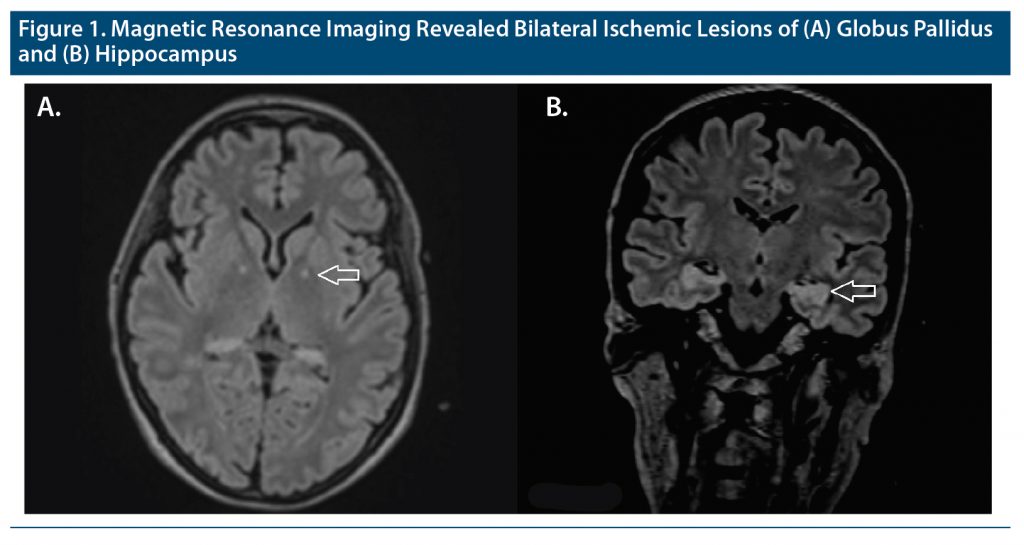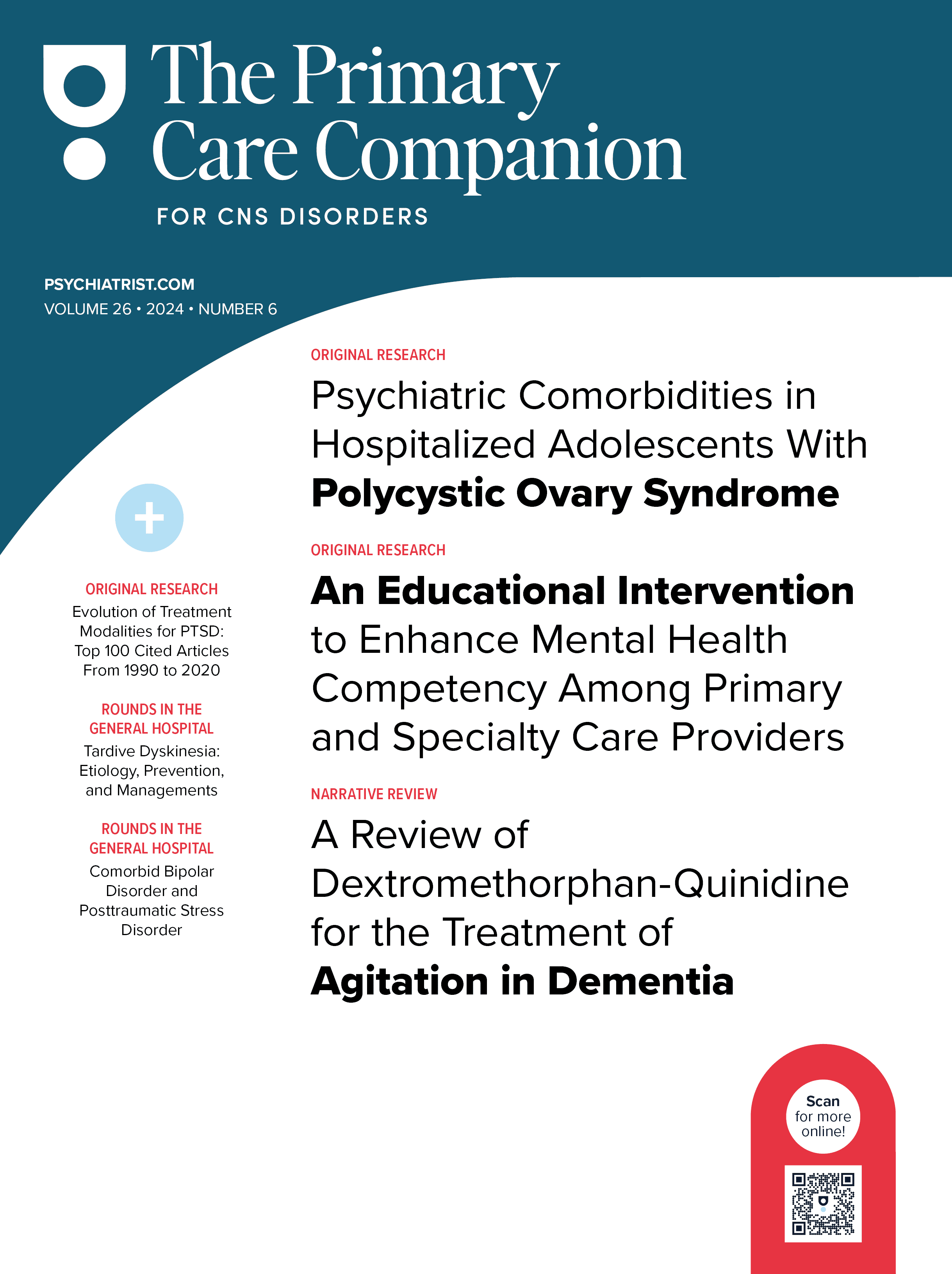Prim Care Companion CNS Disord 2023;25(3):22cr03386
To cite: Godier E, Ifrah G, Le Gal D, et al. Severe amnesia and neuropsychiatric symptoms after a suicide attempt by charcoal burning. Prim Care Companion CNS Disord. 2023;25(3):22cr03386.
To share: https://doi.org/10.4088/PCC.22cr03386
© 2023 Physicians Postgraduate Press, Inc.
aAdult Psychiatry and Addictology Unit, Angers University Hospital (CHU Angers), France
*Corresponding author: Edouard Godier, MD, CHU Angers – 4 rue Larrey 49100 Angers, FRANCE ([email protected]).
Carbon monoxide (CO) self-poisoning by charcoal burning is a common method of attempted suicide in Asia1 but has rarely been described in Western countries. It can lead to chronic and severe disability due to brain damage2 and should therefore be known by clinicians. We present a case of severe amnesia and neuropsychiatric symptoms after a suicide attempt by charcoal burning in France.
Case Report
A 44-year-old woman with a history of breast cancer was found unconscious in her kitchen. An empty package of tamoxifen and a suicide note were found next to her. Surprisingly, the vents in the room had been blocked, and charcoal was burning in a frying pan. The room monoxide rate was measured at 45 ppm by first responders, but the duration of CO exposition was unknown.
In the intensive care unit, the initial evaluation revealed no focal neurologic sign, and her carboxyhemoglobin (COHb) level was measured at 8.1%. Hyperbaric oxygen therapy was not used. Sedation was discontinued on day 2, but the patient remained comatose with a Glasgow Coma Scale3 score of 8. The electroencephalogram (EEG) showed no sign of encephalopathy, but magnetic resonance imaging (MRI) revealed bilateral ischemic lesions of globus pallidus (Figure 1A) and hippocampus (Figure 1B). On day 6, the patient showed awakening signs and quickly regained normal alertness. Evaluation revealed psychomotor slowing and apathy and, most evidently, severe anterograde amnesia associated with retrograde amnesia that extended over 2 years. Therefore, no further information was obtained about her suicide attempt.
The patient was later admitted to a neurologic rehabilitation facility. Neuropsychological evaluation completed 1 month after the attempt confirmed that immediate and delayed free recall were severely impaired. Planning, inhibition, and attentional deficits were also noted. In the same period, obsessive thoughts about her children and compulsive walks appeared. The presentation remained unchanged during the 6-month follow-up period.
Discussion
The lethal rate of CO self-poisoning by charcoal burning is considered moderate,4 but CO has the property to bind to hemoglobin with high affinity and induce hypoxia and oxidative stress reactions. These effects can lead to neuronal necrosis in areas such as the striatum, globus pallidus, hippocampus, and frontal cortex.2 In this case, necrosis of the globus pallidus and hippocampus was visible on the MRI scan. The patient’s severe amnesia was related to the hippocampal damage.
Early symptoms were initially interpreted as tamoxifen self-poisoning, rather than CO self-poisoning, possibly due to moderate CO rates in the room and COHb in the patient’s blood. The lack of awareness regarding charcoal burning as a suicide method in Western countries may also have played a role.5 The diagnosis of CO intoxication requires careful history taking, and CO rates should not play out in clinical decisions, since they can drop rapidly once the room is ventilated and do not correlate well with symptoms.6
If the characteristic setup of charcoal burning in a closed space is found, vigilance should be required during the follow-up of the suicide attempter. Indeed, CO poisoning encephalopathy with neuropsychiatric symptoms including depression, mania, or psychosis may appear after a lucid interval of 2 to 40 days.7 Those delayed neuropsychiatric impairments may occur in up to 30% of survivors.8 In this specific case, in addition to amnesia, obsessions and compulsions appeared 1 month after the suicide attempt.
Suicide by charcoal burning also seems to present a risk of contagiousness in connection with the media,9 known as the Werther effect. Strategies to prevent further use of this method should include media guidelines for reporting on suicide.10
Published online: May 2, 2023.
Relevant financial relationships: None.
Funding/support: None.
Ethical aspect: The Angers University Hospital ethics committee has approved this report.
Previous presentation: Poster presented at the Congrès de l’Encéphale; Paris, France; January 19–21, 2022.
Patient consent: Oral consent was obtained from the patient and her relatives to publish this report, and information has been de-identified.
References (10)

- Chang YH, Hsu CY, Cheng Q, et al. The evolution of the characteristics of charcoal-burning suicide in Hong Kong, 2002-2013. J Affect Disord. 2019;257:390–395. PubMed CrossRef
- Chen NC, Huang CW, Huang SH, et al. Cognitive severity-specific neuronal degenerative network in charcoal burning suicide-related carbon monoxide intoxication: a multimodality neuroimaging study in Taiwan. Medicine (Baltimore). 2015;94(19):e783. PubMed CrossRef
- Jain S, Iverson LM. Glasgow Coma Scale. In: StatPearls. StatPearls Publishing; 2023. Accessed April 7, 2023. https://www.ncbi.nlm.nih.gov/books/NBK513298/
- Yoshioka E, Hanley SJB, Kawanishi Y, et al. Epidemic of charcoal burning suicide in Japan. Br J Psychiatry. 2014;204(4):274–282. PubMed CrossRef
- Chen YY, Bennewith O, Hawton K, et al. Suicide by burning barbecue charcoal in England. J Public Health (Oxf). 2013;35(2):223–227. PubMed CrossRef
- Chen YC, Tseng YC, Huang WH, et al. Acute kidney injury predicts mortality after charcoal burning suicide. Sci Rep. 2016;6(1):29656. PubMed CrossRef
- Park YM, Kim YS. Secondary mania in a patient with delayed anoxic encephalopathy after carbon monoxide intoxication caused by a suicide attempt. Gen Hosp Psychiatry. 2014;36(1):125.e3–125.e4. PubMed CrossRef
- Lam SP, Fong SYY, Kwok A, et al. Delayed neuropsychiatric impairment after carbon monoxide poisoning from burning charcoal. Hong Kong Med J. 2004;10(6):428–431. PubMed
- Chen YY, Chen F, Gunnell D, et al. The impact of media reporting on the emergence of charcoal burning suicide in Taiwan. PLoS One. 2013;8(1):e55000. PubMed CrossRef
- Niederkrotenthaler T, Braun M, Pirkis J, et al. Association between suicide reporting in the media and suicide: systematic review and meta-analysis. BMJ. 2020;368:m575. PubMed CrossRef
Please sign in or purchase this PDF for $40.
Save
Cite





